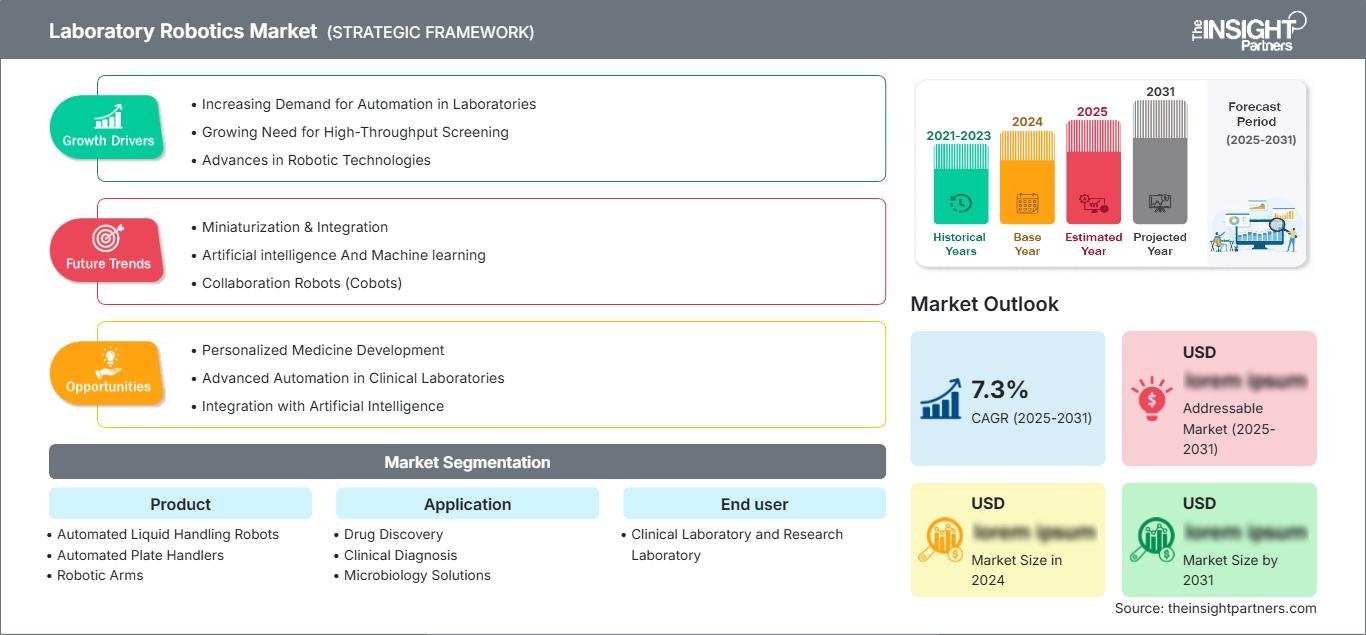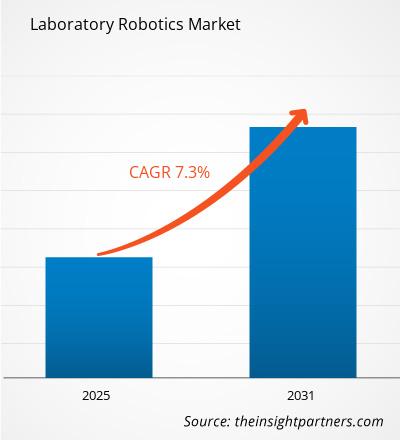Le marché de la robotique de laboratoire devrait atteindre 5,72 milliards de dollars américains d'ici 2031. Il devrait enregistrer un TCAC de 7,9 % entre 2025 et 2031.
Le rapport est segmenté par produit (robots de manipulation de liquides automatisés, manipulateurs de plaques automatisés, bras robotisés, stations de travail d'automatisation de laboratoire, lecteurs et laveurs de microplaques, et autres), application (découverte de médicaments, diagnostic clinique, solutions de microbiologie, solutions de génomique et solutions de protéomique) et utilisateur final (laboratoires cliniques et laboratoires de recherche).
Objectif du rapport
Le rapport sur le marché de la robotique de laboratoire, réalisé par The Insight Partners, vise à décrire le paysage actuel et la croissance future, les principaux facteurs de croissance, les défis et les opportunités. Cela permettra d'éclairer divers acteurs économiques, tels que :
- Fournisseurs de technologies/Fabricants : Pour comprendre l'évolution de la dynamique du marché et identifier les opportunités de croissance potentielles, afin de prendre des décisions stratégiques éclairées.
- Investisseurs : Pour réaliser une analyse approfondie des tendances concernant le taux de croissance du marché, les projections financières et les opportunités tout au long de la chaîne de valeur.
- Organismes de réglementation : Pour encadrer les politiques et les activités du marché afin de minimiser les abus, préserver la confiance des investisseurs et garantir l'intégrité et la stabilité du marché.
Segmentation du marché de la robotique de laboratoire par produit
- Robots de manipulation de liquides automatisés
- Manipulateurs de plaques automatisés
- Bras robotisés
- Stations de travail d'automatisation de laboratoire
- Lecteurs et laveurs de microplaques
- Autres
Application
- Découverte de médicaments
- Diagnostic clinique
- Solutions de microbiologie
- Solutions de génomique
- Solutions de protéomique
Utilisateur final
- Laboratoires cliniques et de recherche
Géographie
- Amérique du Nord
- Europe
- Asie-Pacifique
- Amérique du Sud et centrale
- Moyen-Orient et Afrique
Vous bénéficierez d’une personnalisation sur n’importe quel rapport - gratuitement - y compris des parties de ce rapport, ou une analyse au niveau du pays, un pack de données Excel, ainsi que de profiter d’offres exceptionnelles et de réductions pour les start-ups et les universités
Marché de la robotique de laboratoire: Perspectives stratégiques

-
Obtenez les principales tendances clés du marché de ce rapport.Cet échantillon GRATUIT comprendra une analyse de données, allant des tendances du marché aux estimations et prévisions.
Facteurs de croissance du marché de la robotique de laboratoire
- Demande croissante d'automatisation dans les laboratoires : L'un des principaux facteurs stimulant la croissance du secteur de la robotique de laboratoire est le besoin croissant d'automatisation. Chaque laboratoire souhaite optimiser son efficacité, sa précision et son rendement et, pour cette raison, a déjà commencé à utiliser des systèmes similaires pour effectuer certaines tâches de base et répétitives telles que la préparation et l'analyse d'échantillons, le pipetage, etc. Cela réduit les risques d'erreur et devrait entraîner une augmentation des investissements dans la robotique de laboratoire.
- Besoin croissant de criblage à haut débit : Le secteur de la robotique de laboratoire est en pleine croissance en raison de la demande accrue de criblage à haut débit lors des phases de conception et de développement de médicaments. Au cours du développement de médicaments, les chercheurs doivent évaluer et cribler un grand nombre de médicaments échantillons dans un délai plus court afin d'identifier les composés les plus prometteurs. Les infrastructures robotiques permettent aux laboratoires de concevoir des analyses à haut débit avec une efficacité et une rapidité accrues, améliorant ainsi les processus de criblage pharmaceutique et de développement de diagnostics, et raccourcissant les phases de développement des médicaments.
- Progrès des technologies robotiques : Toutes ces innovations technologiques en robotique propulsent les systèmes robotiques de laboratoire vers de nouveaux horizons. L’intelligence artificielle à usage général, l’intégration de l’intelligence artificielle et des technologies de capteurs sont quelques-uns des avantages des robots de laboratoire. Il en résulte des solutions d’automatisation sophistiquées, conçues pour des activités plus complexes, qui non seulement augmentent l’efficacité des processus opérationnels menacés, mais aussi le champ d’application des robots de laboratoire.
Tendances futures du marché de la robotique de laboratoire
- Miniaturisation et intégration : La tendance générale à la miniaturisation et à l’intégration sur le marché de la robotique de laboratoire nécessite l’utilisation de systèmes robotiques compacts et multifonctionnels. Les nouvelles technologies permettent aux laboratoires d’effectuer des tâches complexes sur une surface réduite et, surtout, à moindre coût. Ces solutions robotiques intègrent de nombreuses fonctions, notamment la manipulation de liquides, le traitement et la préparation d'échantillons, assurant ainsi un flux d'activités efficace, une productivité accrue et une meilleure reproductibilité, caractéristiques essentielles des laboratoires modernes. Intelligence artificielle et apprentissage automatique : L'intersection de l'IA et de l'apprentissage automatique avec la robotique de laboratoire transforme la gestion des données et la prise de décision. Ces robots utilisent des données expérimentales pour alimenter des robots optimisés par l'IA, capables d'adapter leurs procédures et d'améliorer l'efficacité des flux de travail en temps réel. Il en résulte une recherche et un développement plus rapides, plus précis et plus prédictifs, ainsi que des processus de laboratoire efficaces et adaptables aux besoins des utilisateurs. Robots collaboratifs (cobots) : En laboratoire, l'utilisation de cobots, ou « robots collaboratifs », est en plein essor, car ils peuvent être utilisés en présence de chercheurs. Cela allège la charge de travail des scientifiques, la plupart des tâches répétitives étant effectuées par les robots, ce qui leur permet de se concentrer sur des analyses plus complexes. Grâce à leur facilité d'utilisation et à leur adaptabilité, les cobots peuvent s'adapter à une multitude d'applications, favorisant ainsi la créativité dans la conception des expériences et des projets entrepris.
Opportunités du marché de la robotique de laboratoire
- Développement de la médecine personnalisée : Progrès dans le domaine des thérapies personnalisées : La capacité de la robotique de laboratoire à améliorer et à faciliter les approches de criblage à haut débit en fait un élément crucial de la médecine personnalisée. Les systèmes robotiques peuvent rendre le processus de découverte de médicaments plus sophistiqué et assister également le processus d'administration des médicaments, en fonction du génome du patient, ce qui améliore les résultats de santé et génère des avantages économiques.
- Automatisation avancée dans les laboratoires cliniques : Le besoin de tests de diagnostic rapides, précis et de qualité a influencé l'utilisation de la robotique de laboratoire dans l'autogestion clinique. Cela a permis d'optimiser le flux de travail, de minimiser l'intervention humaine et de permettre l'analyse des informations diagnostiques en temps réel, répondant ainsi plus rapidement aux besoins des patients. L'évolution majeure dans l'utilisation des laboratoires cliniques a permis d'accroître la productivité des services, ce qui est bénéfique pour les patients grâce à une accélération des analyses.
- Intégration de l'intelligence artificielle : Acceptation de l'intelligence artificielle dans l'automatisation des laboratoires : Avec le développement de l'intelligence artificielle, des applications intéressantes pour l'optimisation des tâches de recherche sont désormais possibles dans le domaine de la robotique de laboratoire. Les systèmes robotisés permettent de collecter instantanément une grande quantité d'informations. L'IA est capable d'utiliser ces informations pour détecter des anomalies dans les statistiques et suivre leur évolution dans le temps, une tâche généralement trop complexe même pour un humain qualifié. L'interface entre l'IA et la robotique a élargi le champ des possibles en matière de conception expérimentale et a stimulé l'ingéniosité dans les biotechnologies et la conception de nouveaux médicaments.
Marché de la robotique de laboratoire
Les analystes de The Insight Partners ont analysé en détail les tendances régionales et les facteurs influençant le marché de la robotique de laboratoire tout au long de la période prévisionnelle. Cette section aborde également les segments et la répartition géographique du marché de la gestion des troubles du rythme cardiaque en Amérique du Nord, en Europe, en Asie-Pacifique, au Moyen-Orient et en Afrique, ainsi qu'en Amérique du Sud et centrale.
Portée du rapport sur le marché de la robotique de laboratoire
| Attribut de rapport | Détails |
|---|---|
| Taille du marché en 2024 | US$ XX Billion |
| Taille du marché par 2031 | US$ 5.72 Billion |
| TCAC mondial (2025 - 2031) | 7.9% |
| Données historiques | 2021-2023 |
| Période de prévision | 2025-2031 |
| Segments couverts |
By Produits
|
| Régions et pays couverts |
Amérique du Nord
|
| Leaders du marché et profils d'entreprises clés |
|
Densité des acteurs du marché de la robotique de laboratoire : comprendre son impact sur la dynamique commerciale
Le marché de la robotique de laboratoire connaît une croissance rapide, portée par une demande croissante des utilisateurs finaux, elle-même alimentée par l'évolution des préférences des consommateurs, les progrès technologiques et une meilleure connaissance des avantages du produit. Face à cette demande grandissante, les entreprises élargissent leur offre, innovent pour répondre aux besoins des consommateurs et tirent parti des tendances émergentes, ce qui stimule davantage la croissance du marché.

- Obtenez le Marché de la robotique de laboratoire Aperçu des principaux acteurs clés
Points clés de vente
- Couverture exhaustive : Ce rapport analyse en détail les produits, services, types et utilisateurs finaux du marché de la robotique de laboratoire, offrant ainsi une vision globale.
- Analyse d'experts : Ce rapport repose sur l'expertise approfondie d'analystes et de spécialistes du secteur.
- Informations actualisées : Grâce à sa couverture des dernières informations et tendances, ce rapport garantit la pertinence des données pour les entreprises.
- Options de personnalisation : Ce rapport peut être personnalisé pour répondre aux besoins spécifiques des clients et s'adapter parfaitement à leurs stratégies commerciales.
Ce rapport d'étude de marché sur la robotique de laboratoire peut donc vous aider à décrypter et à comprendre le contexte sectoriel et les perspectives de croissance. Malgré quelques points à améliorer, les avantages de ce rapport l'emportent généralement sur les inconvénients.
- Analyse historique (2 ans), année de base, prévision (7 ans) avec TCAC
- Analyse PEST et SWOT
- Taille du marché Valeur / Volume - Mondial, Régional, Pays
- Industrie et paysage concurrentiel
- Ensemble de données Excel
Rapports récents
Témoignages
Raison d'acheter
- Prise de décision éclairée
- Compréhension de la dynamique du marché
- Analyse concurrentielle
- Connaissances clients
- Prévisions de marché
- Atténuation des risques
- Planification stratégique
- Justification des investissements
- Identification des marchés émergents
- Amélioration des stratégies marketing
- Amélioration de l'efficacité opérationnelle
- Alignement sur les tendances réglementaires






















 Obtenez un échantillon gratuit pour - Marché de la robotique de laboratoire
Obtenez un échantillon gratuit pour - Marché de la robotique de laboratoire